My Suisin Inox honyaki 210 mm gyuto was the first high-end Japanese kitchen knife I got and it is still my go-to gyuto. Recently I also obtained a 180 mm Ashi Hamono Ginga gyuto. I had never tried these knives side-by-side and that is what I did last week.
Both knives are similar in a couple of respects: they are both very thin, laser-type knives and they are both made of Swedish stainless steel. The Suisin is made of 19C27 steel and the Ginga is rumoured to be made of AEB-L (or its equivalent, 13C26). They both also come with handles made of ho wood (magnolia) and a buffalo horn ferrule. Since then I had the Ginga rehandled by by Greg Gola of Wabocho, so what you see in the pictures is a handle made of snake wood, a cow horn spacer and a buffalo horn ferrule. All measurements, however, refer to the original Ginga.
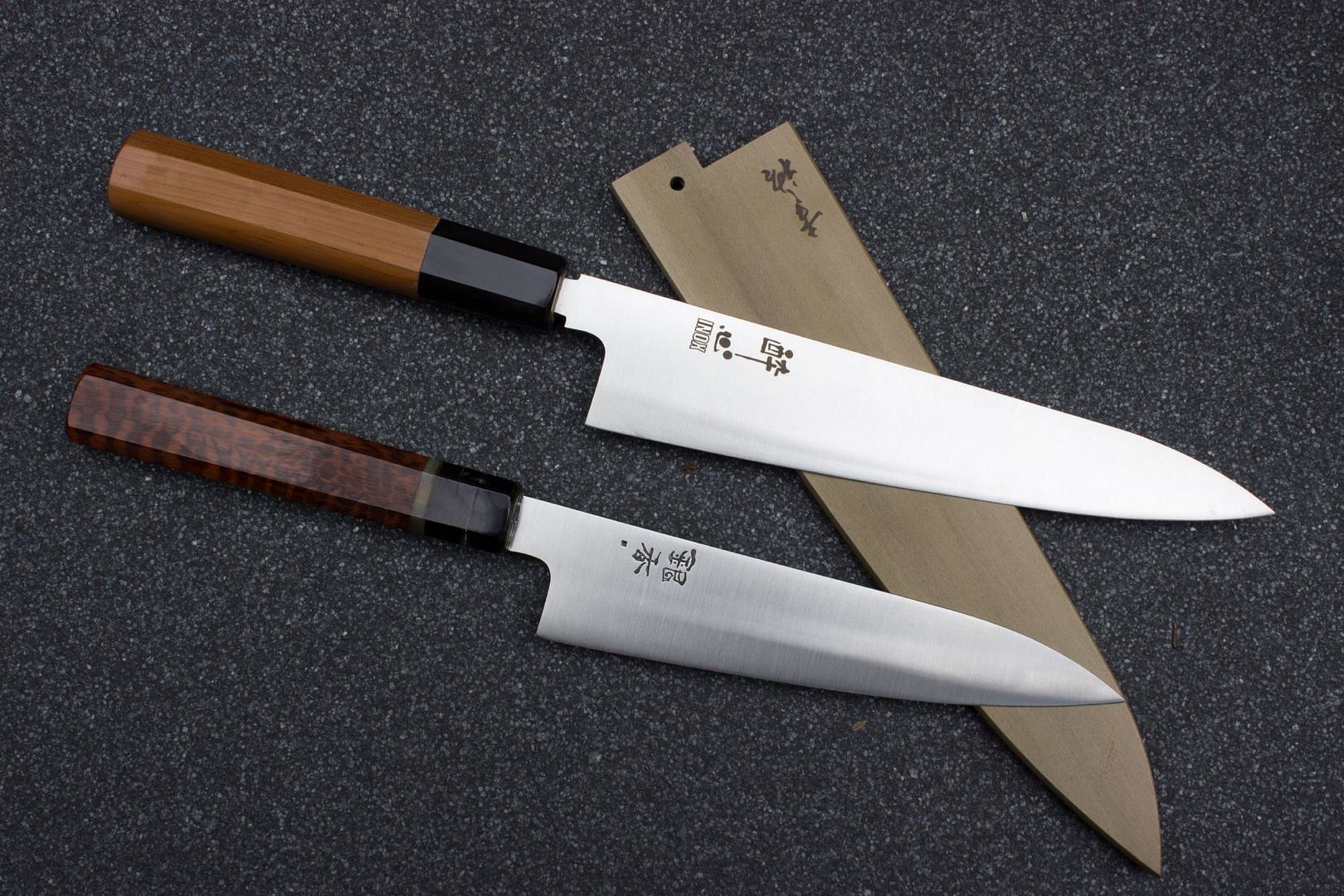
There are differences, too. One being their price. I paid about EUR 300 for the Suisin Inox honyaki and about EUR 110 for the Ashi Hamono Ginga. This may not be an entirely fair comparison, since I bought the Suisin from a shop and the Ginga directly from the maker in Japan, but still it is a large difference. I wanted to know whether the Suisin is worth this difference.
Fit and finish
At first glance both knives look reasonably similar: well-polished stainless steel blades with ho wood and buffalo horn handles. With their nimble blades and ho wood handles, both knives are very light: 117 grams (Suisin) versus 97 grams (Ginga). The balance point of both knives is about two centimeters in front of the ferrule.
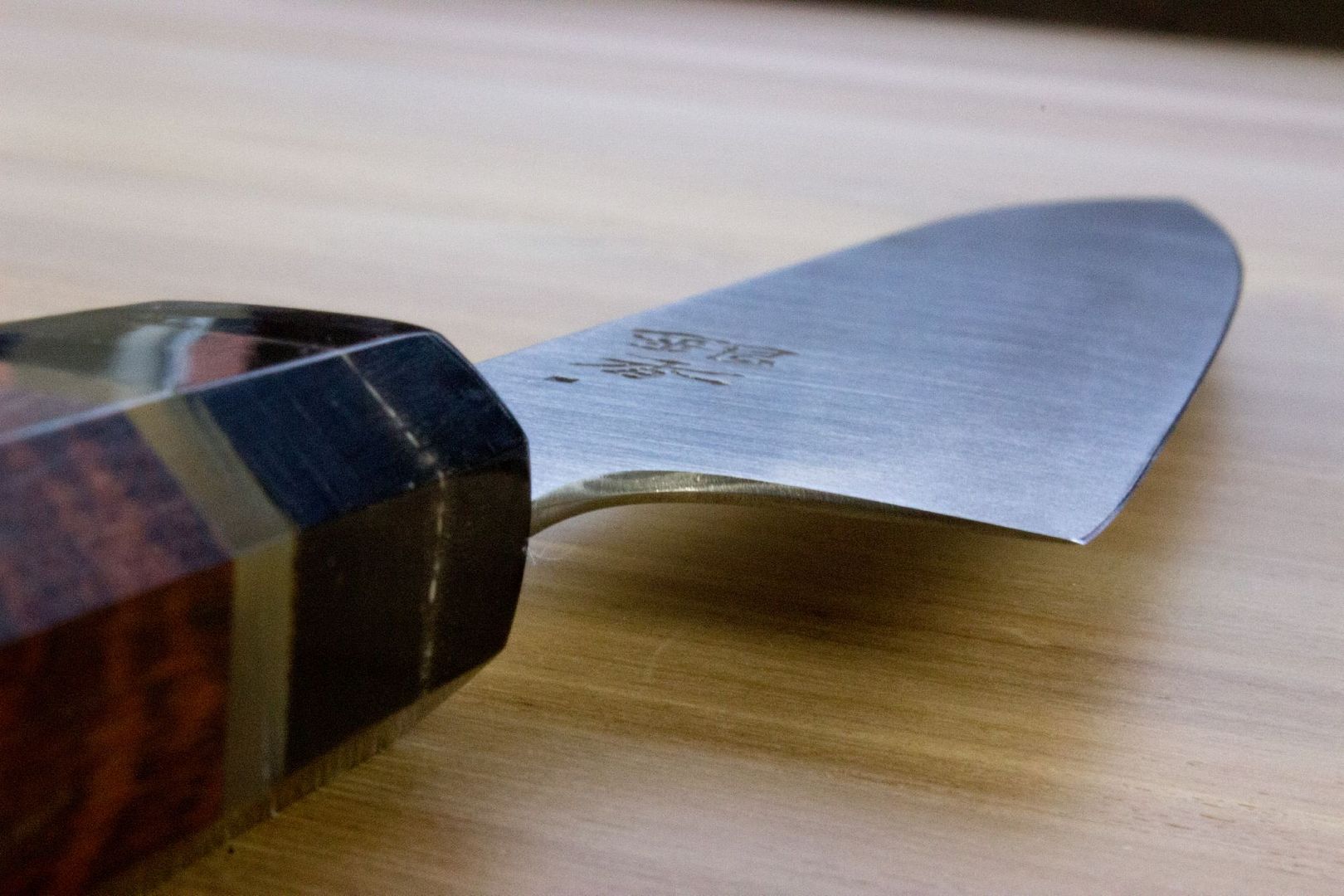
Both knives are well finished, but there are some differences. The spine and the choil of the Suisin have been nicely rounded. The spine of the Ginga has also been rounded somewhat, but not as much as the Suisin. The finish of the handle of the Ginga is slightly better: one can hardly feel the transition from the wood to the horn, whereas the horn of the handle of the Suisin is slightly lower than the wood. The Suisin has a small gap between the blade and the handle: a so-called machi. Some people dont like this as they think it may be unhygienic or uncomfortable. I do like it, since it gives my fingers a little more room for a pinch grip. And Ive never had food stuck to it.
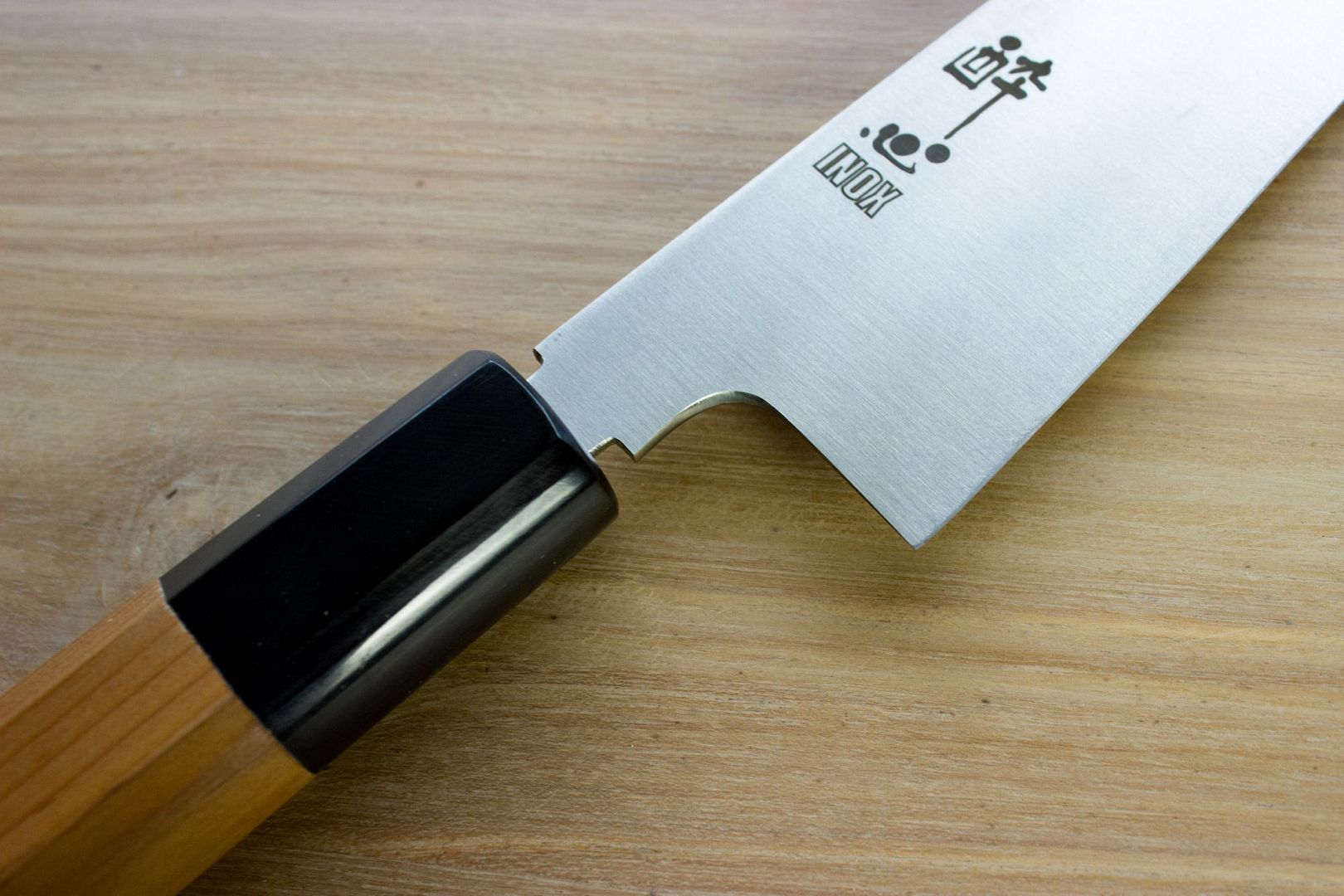
The Suisin comes with a nice ho wood saya.
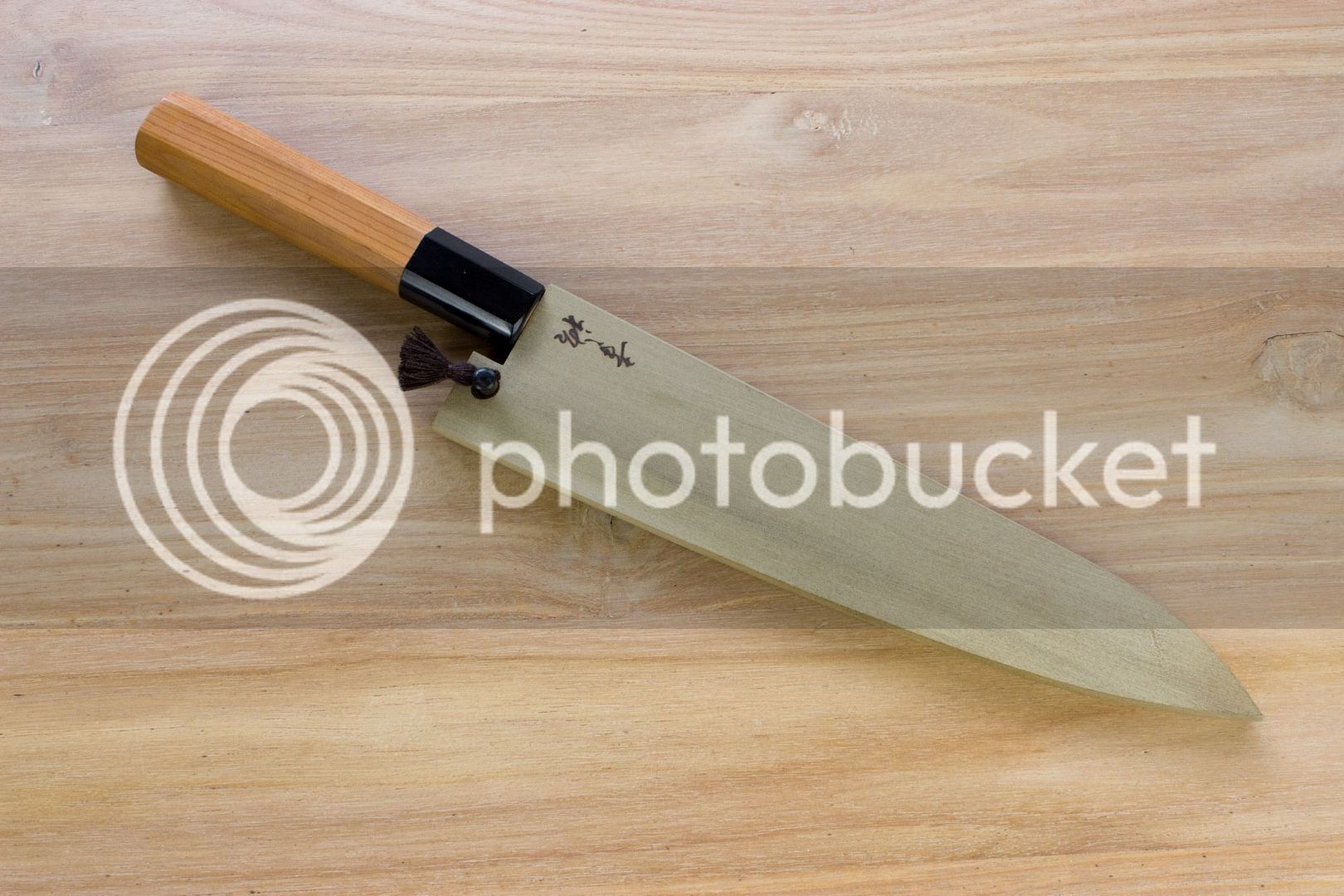
Blades
The Suisin has a profile with a fairly long flat spot, which makes it excellent for push cutting. The profile of the Ginga is slightly more rounded.

Suisin Inox honyaki

Ashi Hamono Ginga (smaller than the Suisin, but these pictures are automatically scaled)
The blade of the Suisin is convex on both sides, whereas the blade of the Ginga is convex only on one side. Both blades are quite thin just behind the edge and were delivered pretty sharp, although they could use some additional sharpening.
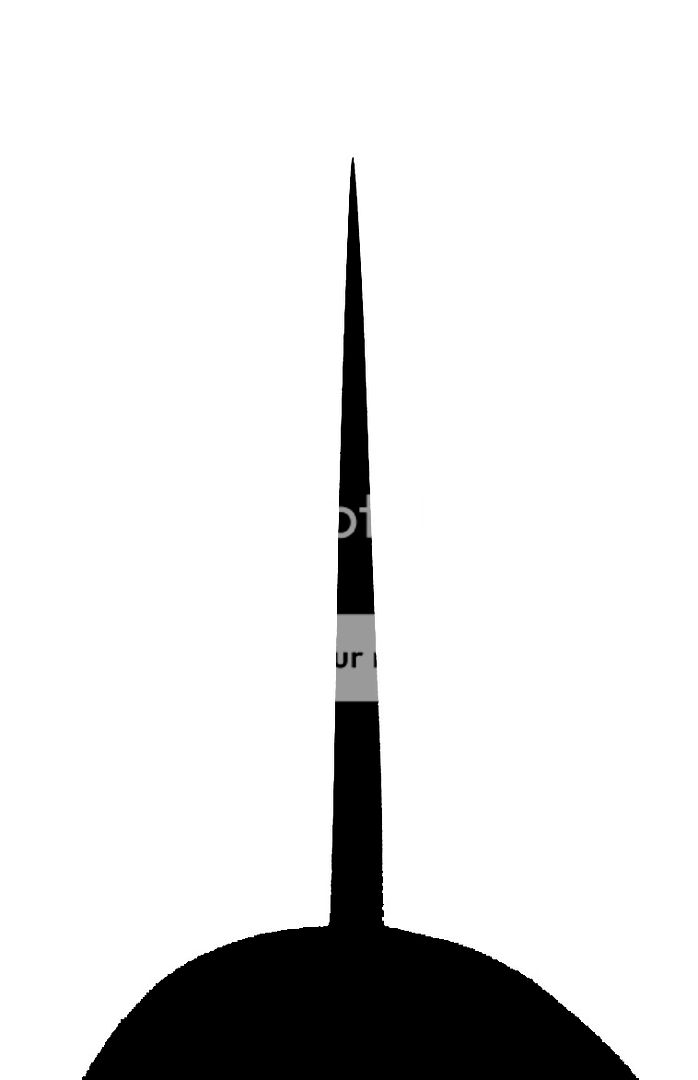
Suisin Inox honyaki
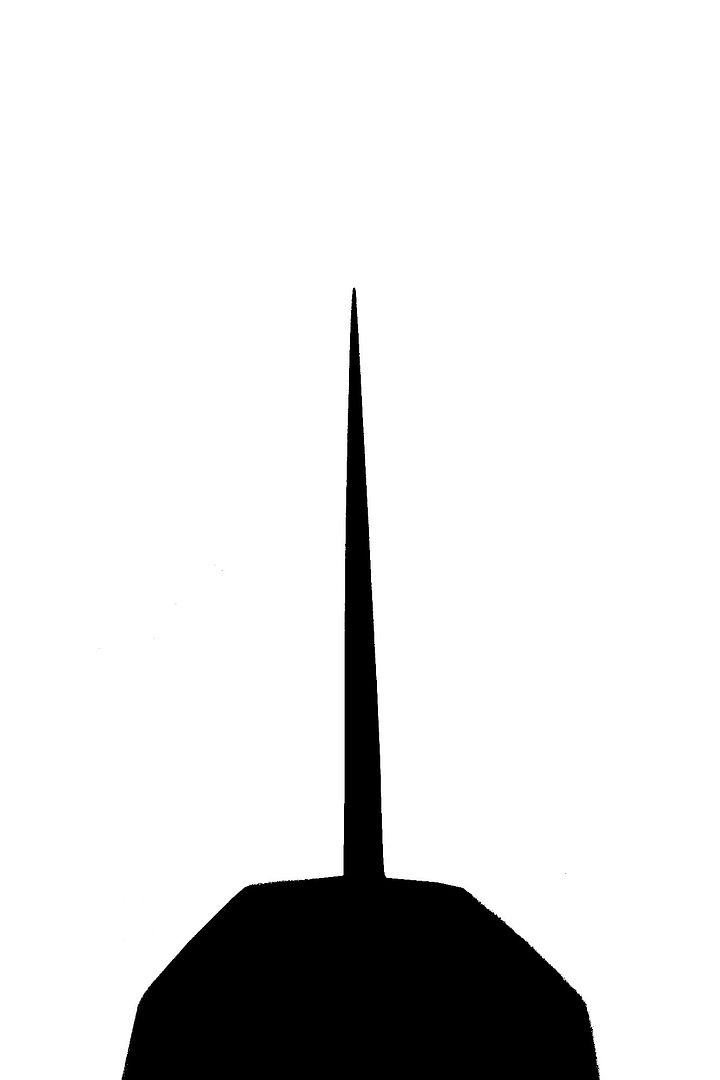
Ashi Hamono Ginga
Both blades are not only very thin, they also have a very nice distal taper. At the spine the Suisin tapers from 2.4 mm above the heel to 0.8 mm at one centimeter from the tip. The Ginga even tapers from 1.9 mm to 0.7 mm.
Use
Before use I first sharpened both knives at 15 degrees with my Chosera stones up to 5000 grit. Jon Broida recommends a steeper bevel on the Suisin with a micro bevel, but I wanted both blades to be comparable.
First the Suisin. Whoa! Sharpening it was an utter pleasure! This blade almost sharpens like carbon steel! In no time I had a burr and finishing the edge was very easy. Suisin has done something very very well. The Ginga also sharpened easily and I got it just as sharp as the Suisin, but the feedback was a little less.
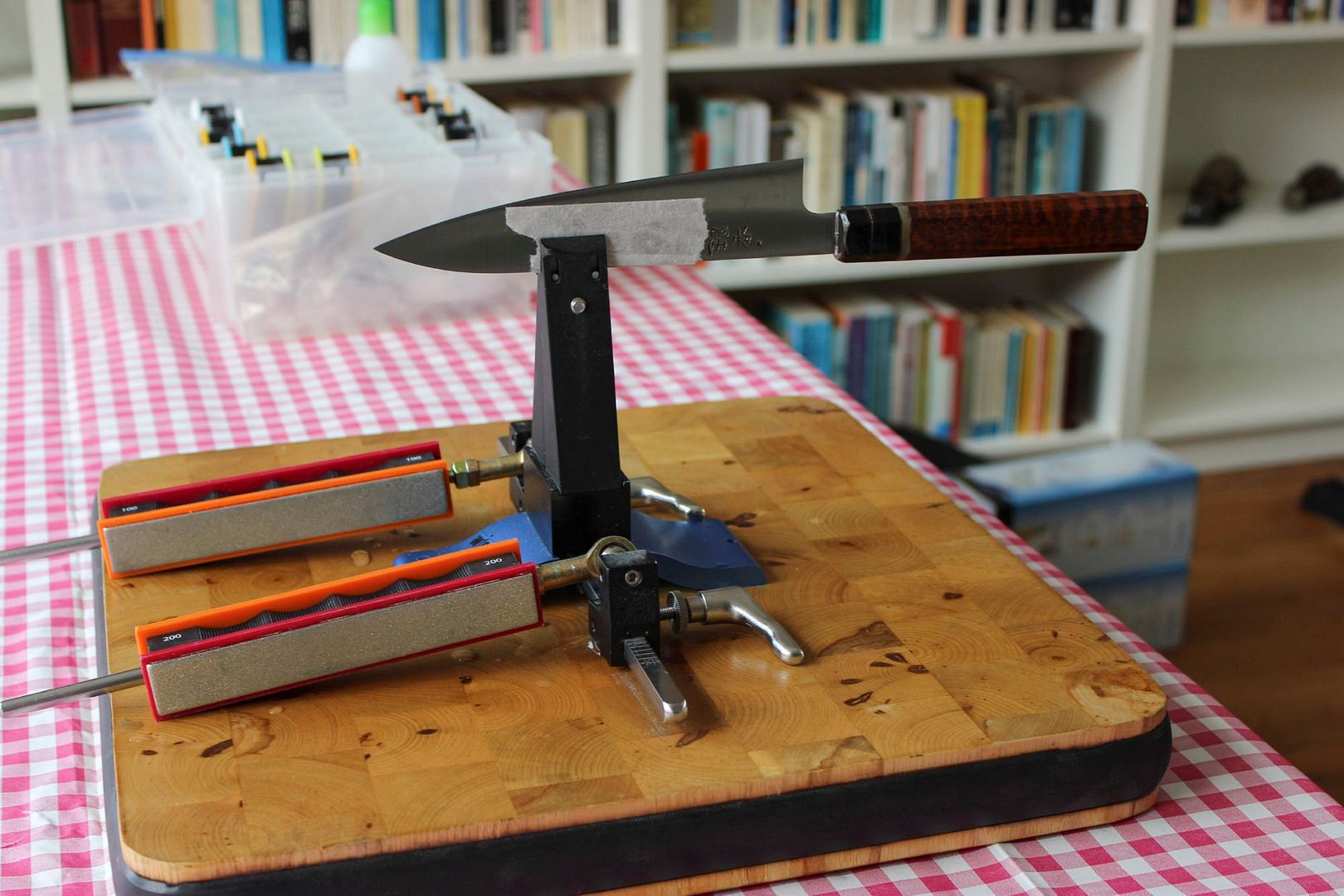
I thought both blades would cut about the same, but there were some differences. First onions. The Suisin dealt with these without any problems. It was slightly less easy with the Ginga: on the horizontal cuts, the blade had a slight tendency to get stuck in the onion. Nothing major, but it went just a bit less smooth than the Suisin. This is probably due to it being convexed only at one side.
On all other veggies, and on meat and fish, the knives performed on par. When cutting some veggies I got the impression the Ginga had even slightly better food release than the Suisin. However, if this is the case, the difference is very small.
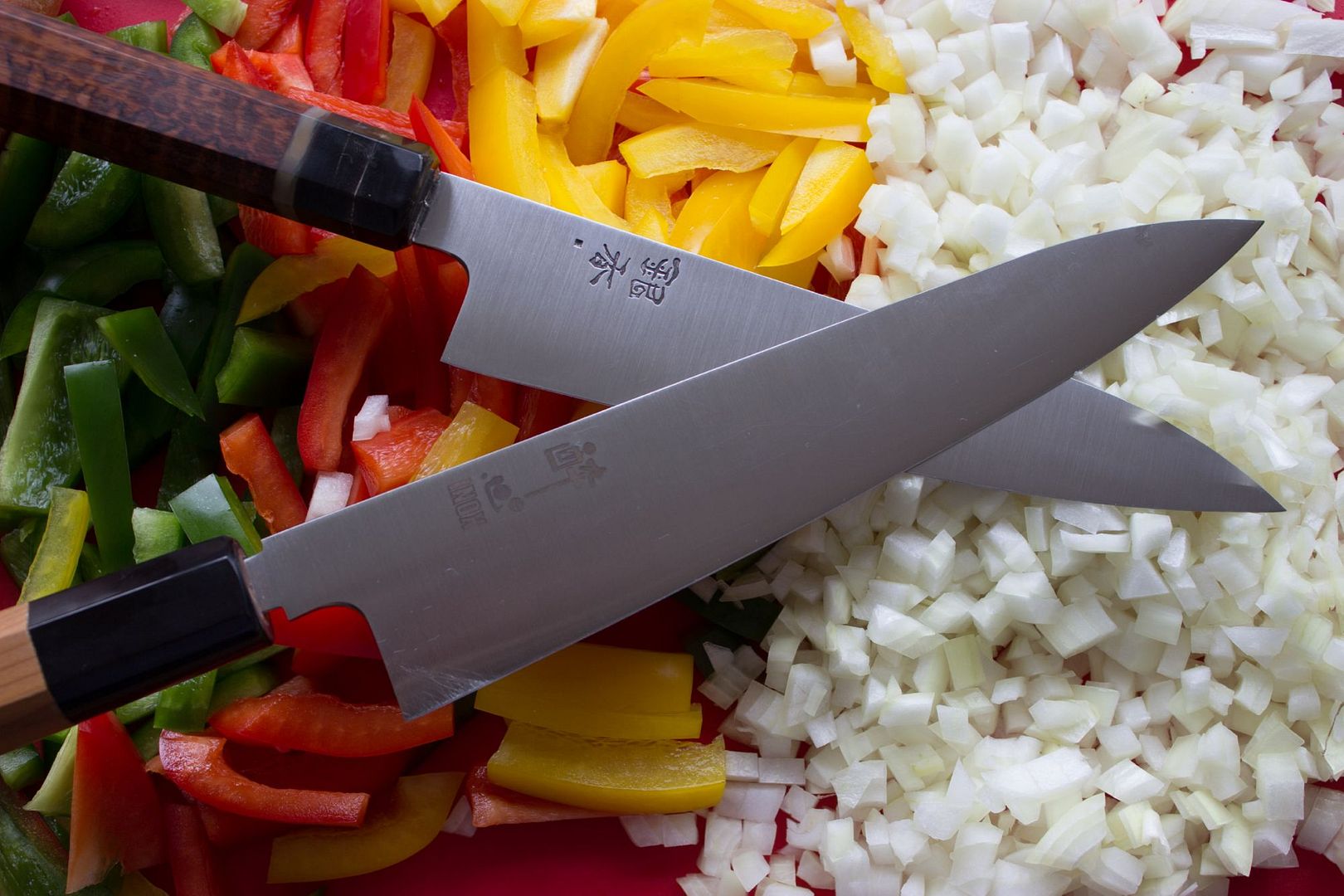
I continued to use both knives alternately in my home kitchen without sharpening or stropping. After about a week I discovered another difference. The Suisin was nearly as sharp as when I had put it to the stones: it could still cut printer paper without rags. The Ginga was less sharp and it could use at least some stropping.
Conclusion
Both the Suisin and the Ginga are great knives that I would recommend to anyone without hesitation. I could notice some differences when cutting with these knives, but the differences are small. The main one is that the Suisin went through onions slightly better.
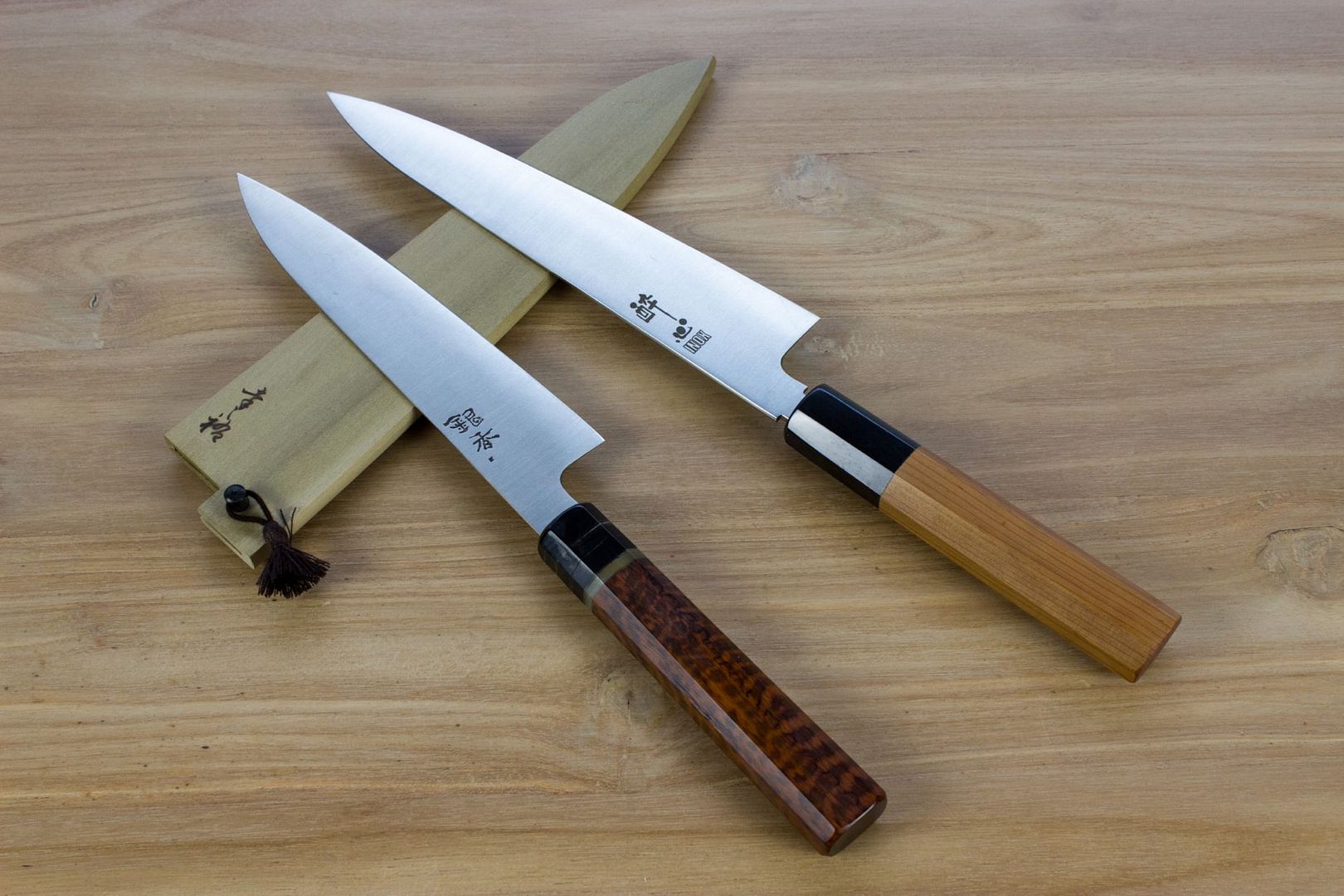
However, the real difference to me is in the steel. Whereas there is nothing wrong with the steel of the Ginga, which I can get nearly as sharp as a carbon blade, the Suisin has the best stainless steel I have ever tried. Sharpening it was almost like sharpening carbon steel and it has a better wear-resistance than that of the Ginga.
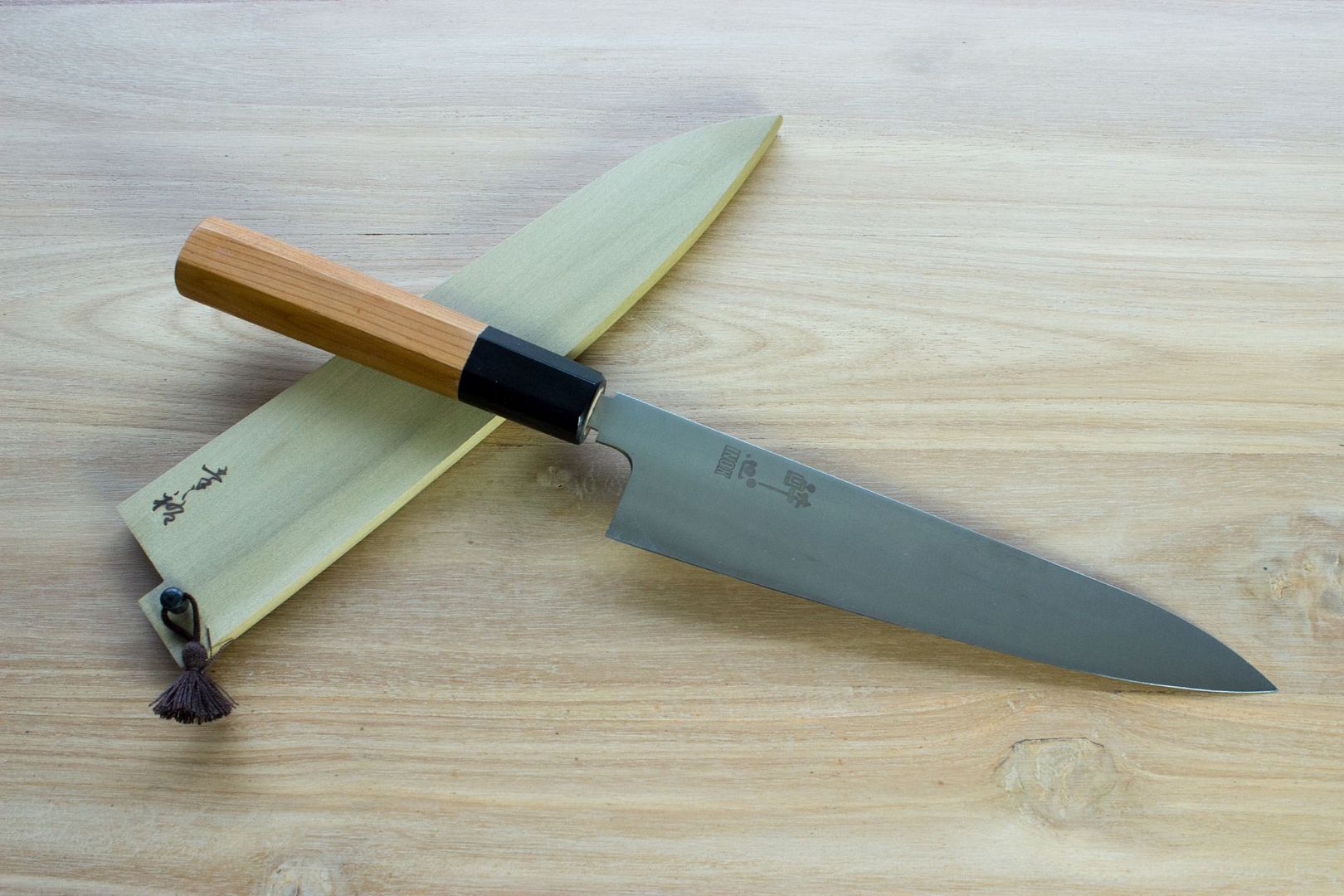
So is the Suisin worth the much higher price? To a knife nut like me it is. And maybe to a professional chef as well. This gyuto is the knife I use 90 percent of the time and it is the best one Ive come across. But if I want to get a very good stainless Japanese gyuto for a friend who is slightly less of a knife nut than me, the Ginga will be very high on my list. It is great value for money.
Factsheets
Click on the factsheets for larger versions.
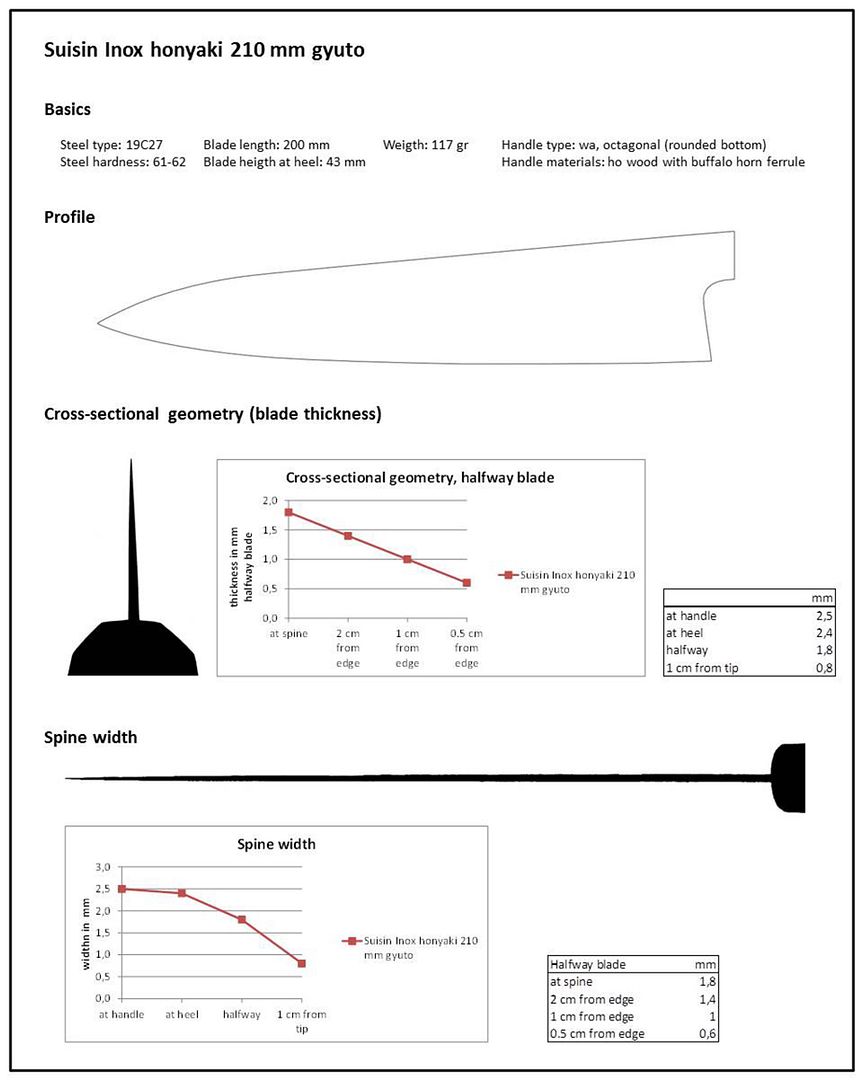
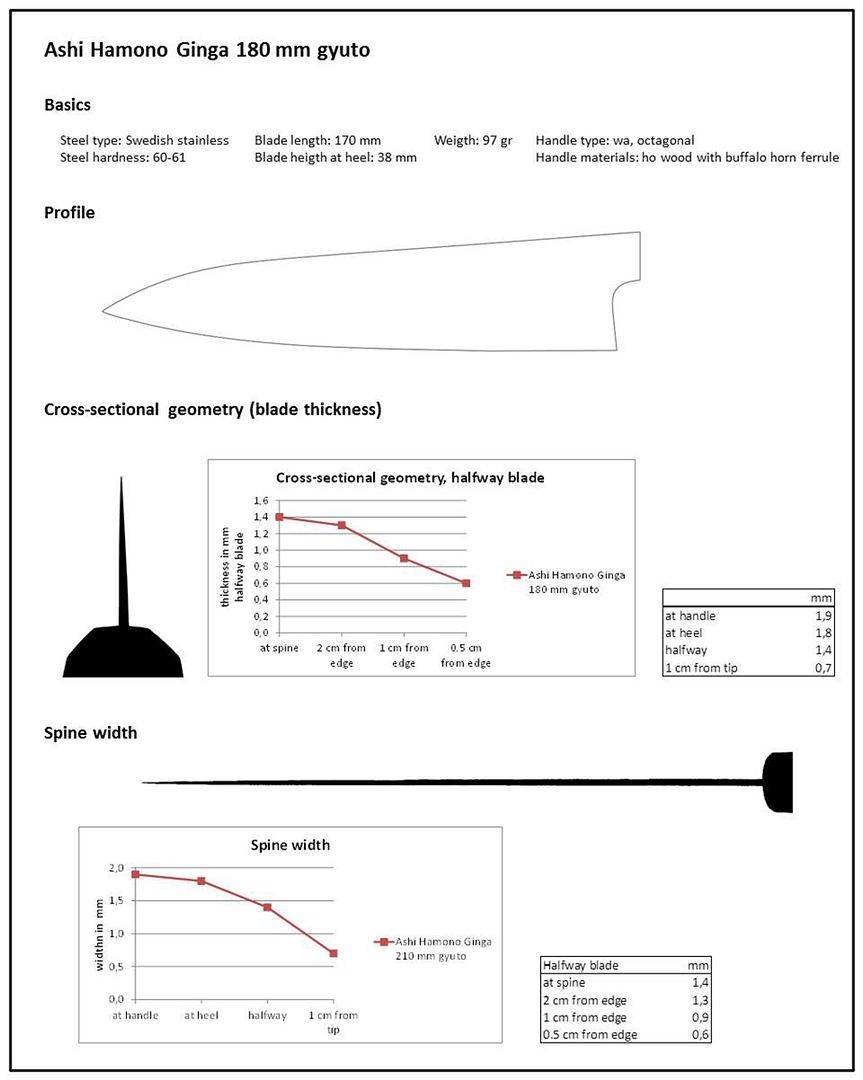
Both knives are similar in a couple of respects: they are both very thin, laser-type knives and they are both made of Swedish stainless steel. The Suisin is made of 19C27 steel and the Ginga is rumoured to be made of AEB-L (or its equivalent, 13C26). They both also come with handles made of ho wood (magnolia) and a buffalo horn ferrule. Since then I had the Ginga rehandled by by Greg Gola of Wabocho, so what you see in the pictures is a handle made of snake wood, a cow horn spacer and a buffalo horn ferrule. All measurements, however, refer to the original Ginga.

There are differences, too. One being their price. I paid about EUR 300 for the Suisin Inox honyaki and about EUR 110 for the Ashi Hamono Ginga. This may not be an entirely fair comparison, since I bought the Suisin from a shop and the Ginga directly from the maker in Japan, but still it is a large difference. I wanted to know whether the Suisin is worth this difference.
Fit and finish
At first glance both knives look reasonably similar: well-polished stainless steel blades with ho wood and buffalo horn handles. With their nimble blades and ho wood handles, both knives are very light: 117 grams (Suisin) versus 97 grams (Ginga). The balance point of both knives is about two centimeters in front of the ferrule.

Both knives are well finished, but there are some differences. The spine and the choil of the Suisin have been nicely rounded. The spine of the Ginga has also been rounded somewhat, but not as much as the Suisin. The finish of the handle of the Ginga is slightly better: one can hardly feel the transition from the wood to the horn, whereas the horn of the handle of the Suisin is slightly lower than the wood. The Suisin has a small gap between the blade and the handle: a so-called machi. Some people dont like this as they think it may be unhygienic or uncomfortable. I do like it, since it gives my fingers a little more room for a pinch grip. And Ive never had food stuck to it.

The Suisin comes with a nice ho wood saya.

Blades
The Suisin has a profile with a fairly long flat spot, which makes it excellent for push cutting. The profile of the Ginga is slightly more rounded.

Suisin Inox honyaki

Ashi Hamono Ginga (smaller than the Suisin, but these pictures are automatically scaled)
The blade of the Suisin is convex on both sides, whereas the blade of the Ginga is convex only on one side. Both blades are quite thin just behind the edge and were delivered pretty sharp, although they could use some additional sharpening.

Suisin Inox honyaki

Ashi Hamono Ginga
Both blades are not only very thin, they also have a very nice distal taper. At the spine the Suisin tapers from 2.4 mm above the heel to 0.8 mm at one centimeter from the tip. The Ginga even tapers from 1.9 mm to 0.7 mm.
Use
Before use I first sharpened both knives at 15 degrees with my Chosera stones up to 5000 grit. Jon Broida recommends a steeper bevel on the Suisin with a micro bevel, but I wanted both blades to be comparable.
First the Suisin. Whoa! Sharpening it was an utter pleasure! This blade almost sharpens like carbon steel! In no time I had a burr and finishing the edge was very easy. Suisin has done something very very well. The Ginga also sharpened easily and I got it just as sharp as the Suisin, but the feedback was a little less.

I thought both blades would cut about the same, but there were some differences. First onions. The Suisin dealt with these without any problems. It was slightly less easy with the Ginga: on the horizontal cuts, the blade had a slight tendency to get stuck in the onion. Nothing major, but it went just a bit less smooth than the Suisin. This is probably due to it being convexed only at one side.
On all other veggies, and on meat and fish, the knives performed on par. When cutting some veggies I got the impression the Ginga had even slightly better food release than the Suisin. However, if this is the case, the difference is very small.

I continued to use both knives alternately in my home kitchen without sharpening or stropping. After about a week I discovered another difference. The Suisin was nearly as sharp as when I had put it to the stones: it could still cut printer paper without rags. The Ginga was less sharp and it could use at least some stropping.
Conclusion
Both the Suisin and the Ginga are great knives that I would recommend to anyone without hesitation. I could notice some differences when cutting with these knives, but the differences are small. The main one is that the Suisin went through onions slightly better.

However, the real difference to me is in the steel. Whereas there is nothing wrong with the steel of the Ginga, which I can get nearly as sharp as a carbon blade, the Suisin has the best stainless steel I have ever tried. Sharpening it was almost like sharpening carbon steel and it has a better wear-resistance than that of the Ginga.

So is the Suisin worth the much higher price? To a knife nut like me it is. And maybe to a professional chef as well. This gyuto is the knife I use 90 percent of the time and it is the best one Ive come across. But if I want to get a very good stainless Japanese gyuto for a friend who is slightly less of a knife nut than me, the Ginga will be very high on my list. It is great value for money.
Factsheets
Click on the factsheets for larger versions.






